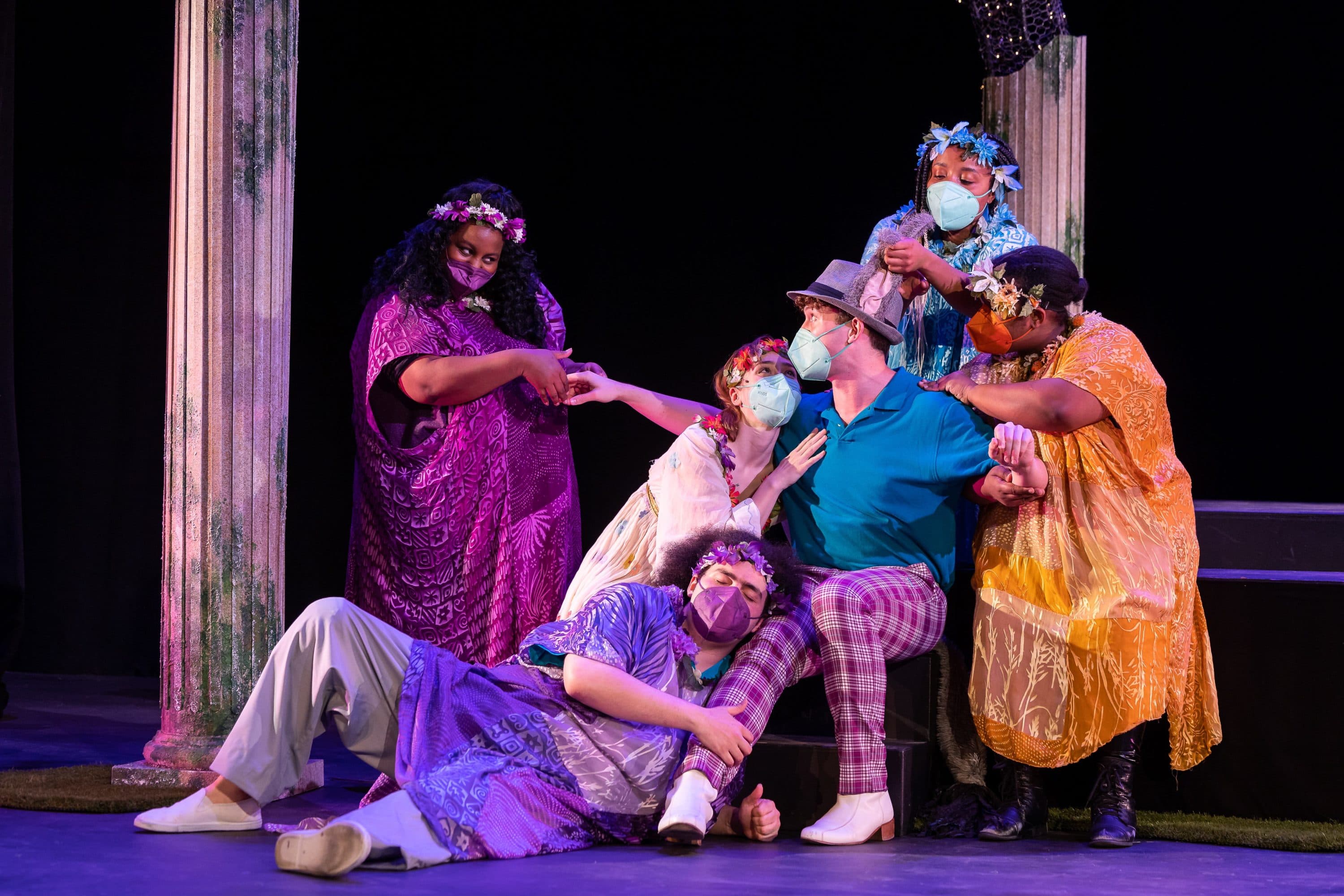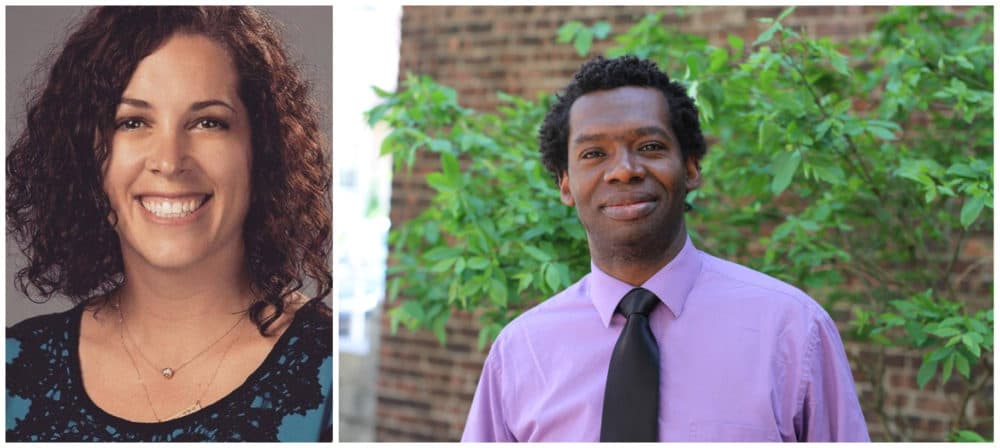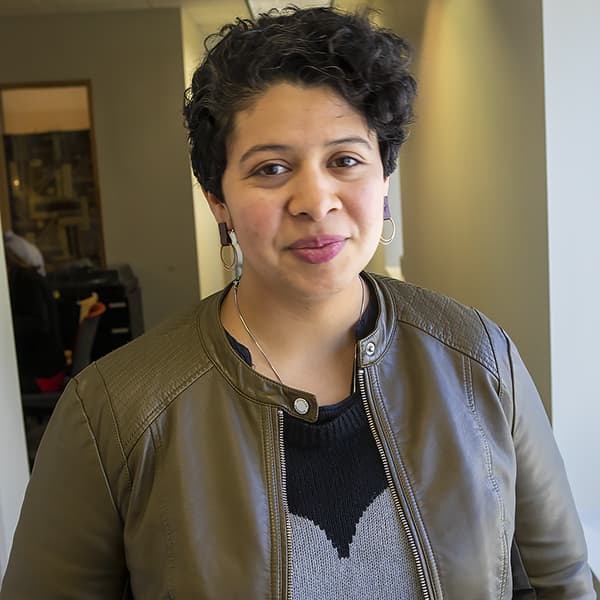Advertisement
A night of accessible theater with Commonwealth Shakespeare Company

Rachel Berman-Kobylarz remembers once walking out of a play. Her family loved going to shows. Now a faculty member at Northeastern University who teaches American Sign Language and interpreting courses, Berman-Kobylarz always loved the tradition and the theater. She didn’t want to be left out simply because she is Deaf. Sometimes she would try to interpret the play herself. Other times, if someone gave her the script, she’d attempt to read in the dark during a performance. Rarely were there accommodations to be able to appreciate the art fully. That’s why she got excited when her parents told her there would be interpreters at the next play.
Today, she doesn’t remember the play, but she’s never forgotten her disappointment. “I got there and there were no interpreters,” she said. “And at that moment, I walked out. I told my family, ‘No, I can't do this anymore. I'm done. Enough is enough.’”
On May 7, Berman-Kobylarz serves as the director of Artistic Sign Language for a presentation of Shakespeare’s “A Midsummer Night’s Dream” at the Strand Theatre in Dorchester as part of an event the Commonwealth Shakespeare Company is holding called “Access-Palooza.” The company will provide open captioning, ASL interpretation, audio description and assisted listening. There will also be minor adjustments to sound and lighting to make the space better equipped for people with sensory processing concerns. One of Shakespeare’s beloved comedies about bewitched lovers, the group’s Stage2 Performance Series adapts the play for students and teachers. The text is abridged, created with a 6th through 12th-grade curriculum and audience in mind, and focuses on themes like authenticity, popularity, acceptance and respect.
Working alongside Berman-Kobylarz on this effort is Christopher Robinson, the disability and access services outreach and training coordinator at Boston University as well as an accessibility advocate with CSC. They spoke to WBUR's Cristela Guerra recently about what it means to make theater welcoming and accessible for all.

Cristela Guerra: How do you interpret a play in Old English through sign language?
Rachel Berman-Kobylarz: The impact is missed sometimes. We are at the mercy of the interpreter’s hands, so to speak. So it comes down to who the interpreters are, their background, their experience in theater, and their comfort with the script. There's a whole host of things that they need to be comfortable with. It's very specialized interpreting for the theater and for the arts, much like public speaking or interpreting for the governor.
"It's very specialized interpreting for the theater and for the arts, much like public speaking or interpreting for the governor."
Rachel Berman-Kobylarz
Christopher Robinson: Like “Hamlet,” for instance — we know anyone who goes to see “Hamlet” was waiting for the “To be, or not to be” soliloquy. So there's a large deaf audience that goes to see “Hamlet,” and there's a deaf person who is very versed in Shakespeare. And they go and they're ready. They're waiting for that line and they're looking at the interpreter. And it's possible that this interpretation is very flowy, and the deaf person is annoyed because they came to see the iambic pentameter “To be, or not to be.”
How do you manage people’s expectations and still make everybody happy?
Berman-Kobylarz: Exactly. That is the million-dollar question right there.
Robinson: Well, one response is ASL-interpreted theater is not equal access, period. Often we assume that we're operating on this idea that we're putting two sign language interpreters for say, “Hamilton.” There's a cast of 40 people in Hamilton. We have two interpreters or three interpreters sometimes. It is a myth that we are providing equal access. You have to throw that idea out the window. Those interpreters are not there to give people an equal experience. They're there to give access to what is being said on the stage. And that's not equity.
"Those interpreters are not there to give people an equal experience. They're there to give access to what is being said on the stage. And that's not equity."
Christopher Robinson
What do you have to consider as you prepare to interpret a show?
Berman-Kobylarz: People think that sign language is universal, which is not true. I teach American Sign Language. That's one thing that I'm shocked to learn that everybody thinks that it's universal. Other countries speak different languages, like Mexico. They speak Spanish. But they would also have their own sign language. So related to Shakespeare — Shakespeare is from the U.K. so they use British sign language…
Robinson: In order to give you a visual description of what was just signed — the sign gesture [in the U.S.] is as if you're picking up a literal spear. And passing it in a forward-facing direction. So to phonetically and iconically grab a spear, shake it and throw it. And that's been kind of the nomenclature of Shakespeare in American Sign Language from this U.S. perspective. But in British sign language, what Rachel is going to do is demonstrate how our British peers refer to their William Shakespeare.
[Berman-Kobylarz uses her hands to circle her neck as if she’s donning Shakespeare’s pleated collar, also known as a ruff.]
Robinson: Sign language, I believe, is closer to what William Shakespeare intended in the first place. In any theater program, they will say that this work is not meant to be read. It's meant to be seen and heard. So therefore, the nature of the language and the rhythm is not on the page. It has to be put in a space.
How does the deaf audience identify which character the interpreter is signing and who they represent?
Berman-Kobylarz: Sometimes we need to add information prior to the show. So before the curtain opens, the interpreting team will introduce themselves and give a short synopsis of the story and who the characters are, their sign names, all of that. And if there're too many characters, maybe we will just focus on the main characters and the interpreters will introduce themselves and who they'll be interpreting for.
"We're trying to change that lens and be authentic with all of the facets. It's not easy. It's a challenge."
Christopher Robinson
Robinson: We also have to work on character development. We have to have access to the director. We’re studying the work. We see how the actors walk, what they look like. Are they hunched over? What their stature is, what their costumes are like. We talk with the costume designer about their costume choices. Do they have a vest? Do they have a collar?
What role does representation play when it comes to equity and accessibility?
Robinson: We're always having this ongoing conversation. It's not just about translating the script…Where is authentic representation? Who's in the process? Often, unfortunately, we try to fool the deaf audience. Are deaf people being involved in the process? Are blind people or people with low vision involved in the process? Deaf people, blind people are not just passive…no, we are directors, we are actors, we are involved. We're trying to change that lens and be authentic with all of the facets. It's not easy. It's a challenge. And the pool of Black, Indigenous [interpreters] are slim. Very slim.
All of the performances of “A Midsummer Night’s Dream” at The Strand Theatre on May 7 and 14, along with the performances for schools on May 6 - 17, will be captioned.
